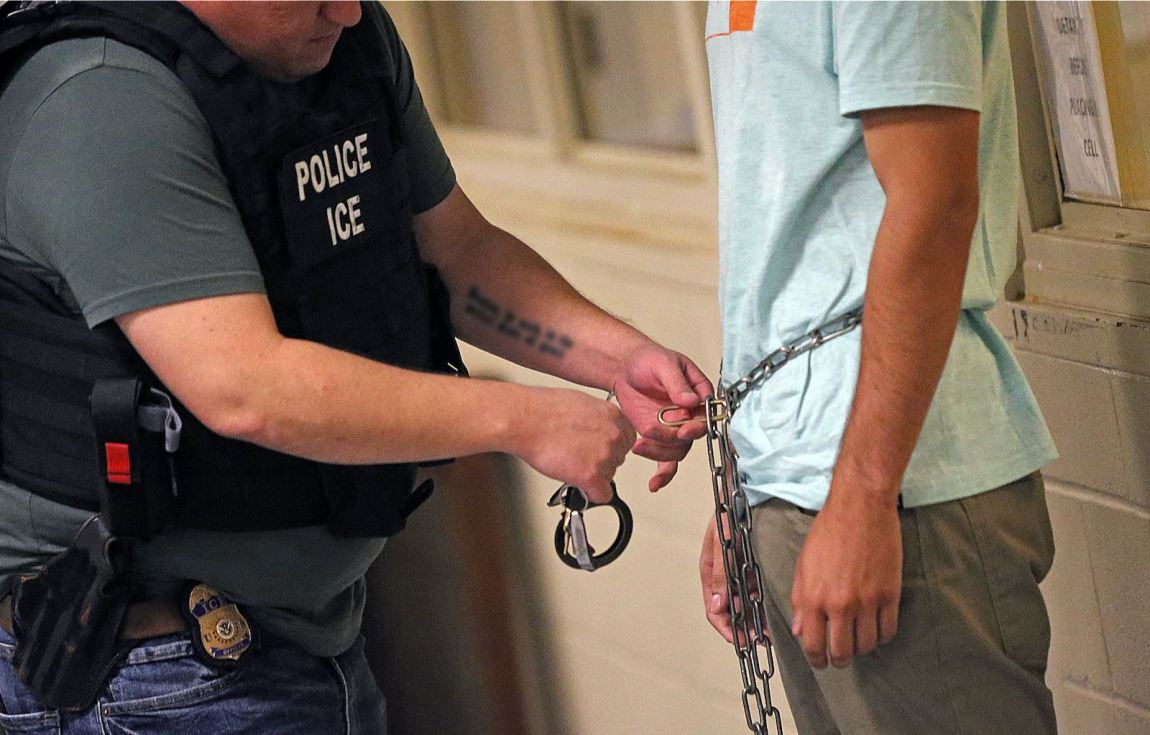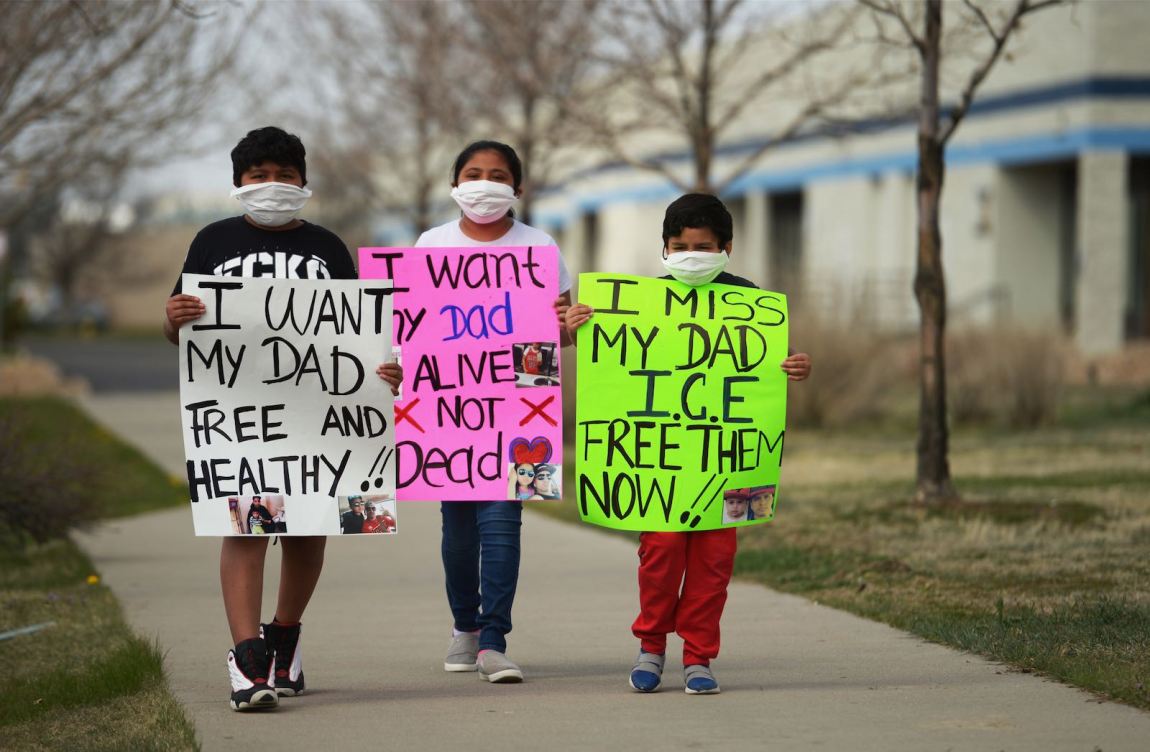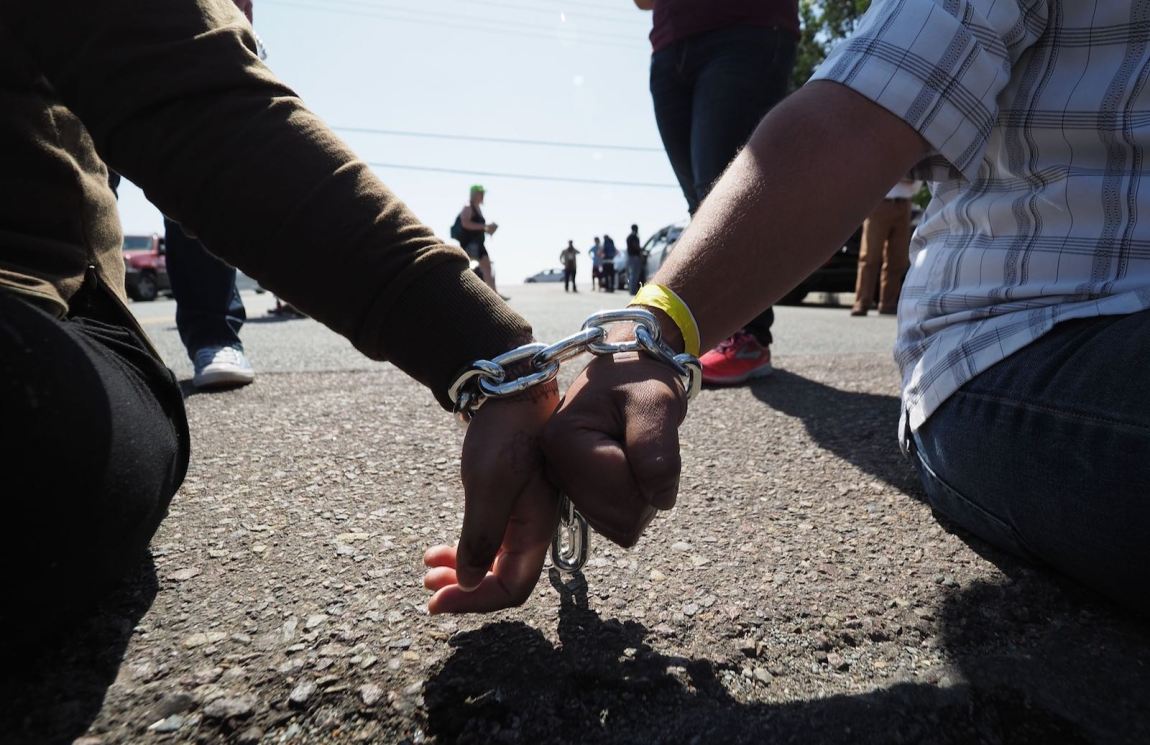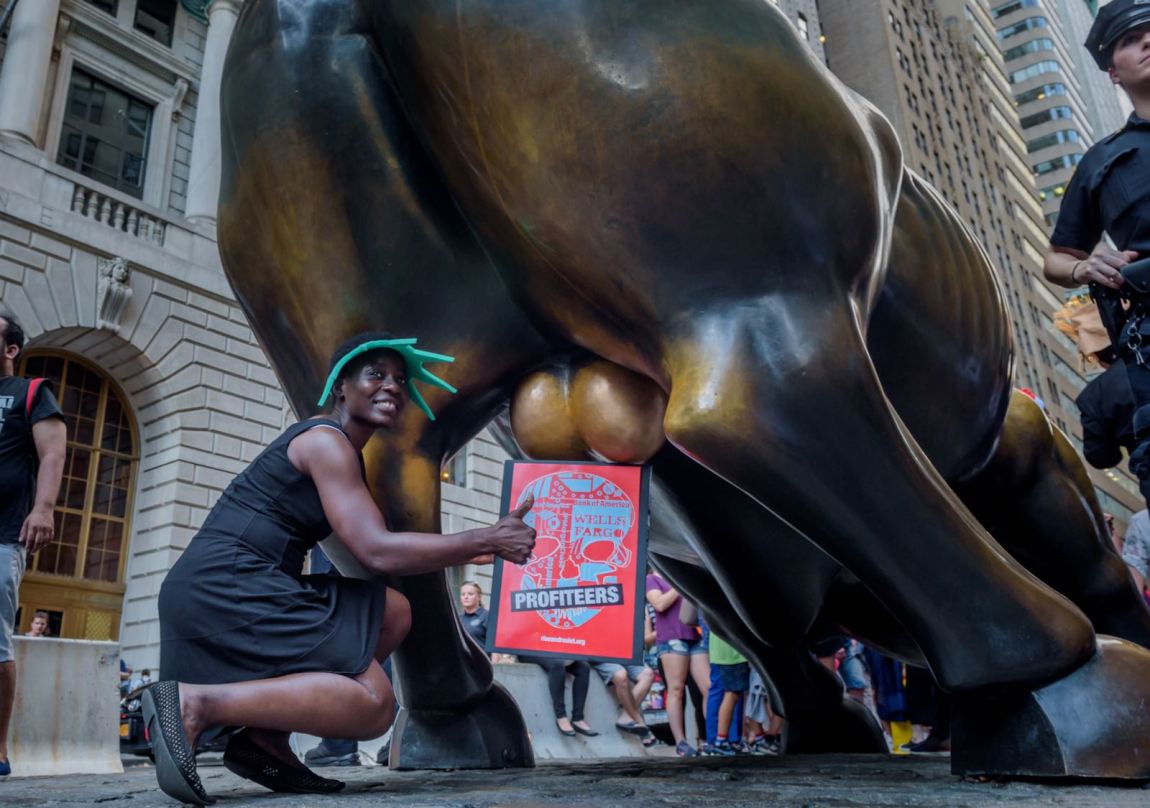In 2018, Guinean asylum-seeker Aboubacar Soumah was presented with an opportunity to get out of immigration detention under the United States immigration bail bond system. The opportunity came with a price tag of $15,000. With “only $59 to his name,” as a public radio report put it, and no network of friends or relatives in the country, Soumah was forced to remain in detention indefinitely.
Soumah’s case is far from unique. As in the US criminal justice system, an immigration bond can be offered to a person in custody at the discretion of a judge as a way of securing their release while their case is pending. Officially, bonds are intended to guarantee that the person will attend future court hearings, and the bond amount paid to Immigration and Customs Enforcement (ICE) should be refunded once the case is resolved. But few judges grant bail, and those who do often set exorbitantly high amounts. And those who do have access to funds to pay a bond can then spend years trying to get their money back, and not always successfully. Those who can’t make bail face an impossible choice: remain in jail awaiting a hearing in backlogged courts or go deep into debt to come up with the money.
Even the option of “voluntary departure”—the chance to effectively self-deport without being automatically barred from legally returning at a later date—carries a bond of at least $500. Given the high costs—both human and financial—of seeking asylum in the United States, it’s understandable why some people make this “choice.”
This penalization of poverty is part of a wider trend: the increasing extraction of profit from immigrant communities by corporate interests in the United States. The ways that private companies profit from detaining immigrants are well known. Less so is the money made from setting them free.
Proponents of immigration bonds argue that they function as collateral to ensure people do not abscond on release. Immigrant rights activists contest this, and cite the Department of Justice’s own data from 2018 (the last year available) that 75 percent of immigrants attend mandatory court hearings, a number that researchers at the Transactional Records Access Clearinghouse at Syracuse University have found could be even higher. Criminal justice statistics reveal a similar trend. District of Columbia virtually eliminated its criminal bail system back in 1992; when assessing the effect of that ruling nearly a quarter century later, in 2016, D.C. Superior Court Judge Truman Morrison concluded: “There is no evidence you need money to get people back to court. It’s irrational, ineffective, unsafe, and profoundly unfair.”
An increasing number of states are considering abolishing bail for criminal cases, with New York State last year passing one of the most progressive pieces of bail reform legislation in the country (though not without controversy). In the meantime, thousands of criminal court defendants are, in effect, coerced into making guilty plea deals to secure release from jail, simply because they cannot afford bail. The overwhelming majority of them are Black people and other people of color. Asylum-seekers in immigration detention, who are unlikely to have much, if any, financial capital in the United States, often have no choice but to remain imprisoned—potentially for years—while their claims are considered. All the while, the for-profit detention center contractors gladly accept $134 per person per day from the federal government to keep them there.
Criminal court judges at least are required by law to consider a defendant’s financial circumstances when setting a bail amount and to accept partial payments. No such requirements exist for immigration cases, with people usually expected to pay the full cash amount upfront before release. Although $1,500 is the legal minimum for immigration bail, in 2018 some 40 percent of bonds were above $10,000, and they can be set as high as $60,000, according to Jamila Hammami, the founding executive director of Queer Detainee Empowerment Project (QDEP), which crowdsources bail money for those unable to pay.
Hammami also explains that a lack of clarity leads to wildly different amounts being set: “There are constant issues with judges believing that ICE should determine bond amounts, with ICE stating that it’s to the judges’ discretion.” Few, in fact, even get the opportunity to post bail. Although the number of bonds granted varies wildly by jurisdiction, on average only one in four detained immigrants was given the option between 2014 and 2018.
Immigration judges regularly deny bail to those they deem to be “a flight risk” or a “danger to public or national security,” placing the burden of proof on immigrants themselves. However, as advocates and researchers have pointed out, which people are deemed “dangerous” is often marked by racial bias. The Trump administration’s repeated public efforts to discredit asylum-seeker claims as “scams” or “hoaxes” have combined with new legal directives and limited access to lawyers to further deny immigrants their legal rights: granted asylum claims are down by nearly 37 percent since financial year 2016, and the overall grant rate is 40 percent lower than during both the Obama and Bush administrations. Establishing an image of asylum-seekers as dangerous criminals is a way to deny them their legal rights. It also further reduces their chances of being offered bail.
Advertisement
For those who do manage to obtain bail, later securing a refund can take years, and if they don’t have a lawyer or English proficiency, some never see their money again. As of July 31, 2018, ICE held a staggering $204 million in unreturned bond money. This pot had increased by 40 percent since 2014, when the Obama administration detained thousands of immigrant families fleeing violence from Central America. It has been people like these, whom the US government has refused to recognize as refugees despite United Nations directives naming them as such, who have filled ICE coffers, while their rights, ostensibly guaranteed under international law, have been ignored. This abusive system has only grown.
“The Trump administration has successfully expanded how they criminalize immigrant communities so that everyone has become a target,” explains Gabriela Marquez-Benitez, the membership director at Detention Watch Network (DWN), a national coalition fighting to end immigrant detention. “While President Obama’s administration solidified the detention infrastructure, the Trump administration has made it clear that it intends to expand on that infrastructure to detain upward of sixty thousand people per day, as of fiscal year 2020.” The proposed increase is astronomical: in fiscal year 2019, ICE detained a daily average of forty-two thousand people. Most were housed in for-profit prisons run by corporations like GEO Group and CoreCivic—companies whose stock prices have skyrocketed since Trump signed his first set of executive orders on immigration, in January 2017.
To meet these new detention targets, the Trump administration began foreclosing access to bail. In April 2019, Attorney General William Barr struck down a decades-old policy that granted asylum-seekers the right to request bond, making asylum-seekers wholly reliant on ICE to grant them parole (a waiver to leave detention, albeit under strict government supervision). By that point, the frequency of parole granted to asylum-seekers had already dropped to near zero in some ICE field offices, down from 92 percent in just five years. Barr’s ruling prompted an immediate challenge from immigrant rights groups. It was eventually overturned by a federal appeals court in March 2020, when the government was ordered to resume bond hearings.
Despite the discriminatory nature of immigration bonds, Barr’s attempt to revoke them reveals that a perversely more profitable expansion of the indefinite detention regime remains possible. Privatized detention and bond money are just two elements of this profiteering equation—monetizing surveillance is a notable third one. “Not only is bond money going straight back to the pockets of the Department of Homeland Security, but we’re seeing a rise in groups that disguise themselves as nonprofits to gain from the bond system,” said Marquez-Benitez.
Companies like Libre by Nexus (Libre) market private services that get people out of detention—at a price. As immigration judges are more likely to grant bail when the individual is not deemed to be a flight risk, Libre offers to monitor a client’s location through an electronic GPS ankle bracelet, while providing bail money loans. This form of outsourced detention is cheaper for the state than housing someone in a dedicated center, largely because it shifts an increased cost burden onto immigrants and their communities.
At 2019 rates, a Libre client pays an initial $620 service fee before, in effect, renting an ankle monitor from the company for $420 per month. The client also pays Libre a one-time, nonrefundable 20 percent premium on the bond amount covered by the loan. Only if the client puts down more than 80 percent of the bond, and pays the rest in installments, will the ankle bracelet be removed. These devices require the wearer to spend hours close to an electric outlet to charge them; they can also cause sores, bruising, and, occasionally, burns. For lost or damaged monitors, clients can incur costs of up to $3,950.
Libre has seen its bottom line surge since 2013 (as of 2017, the company was reporting annual revenue of $30 million). Longer processing times for asylum claims and impossibly high bond amounts have forced more people to look to private companies for help in getting out of detention. Libre founder Mike Donovan calls the scheme “an opportunity” for immigrants, but it has left human rights activists battling against misleading contracts, predatory sales pitches, and exorbitant fees. “I’ve even heard of cases where [a client’s] not paying back the money on time can mean Libre gets to press criminal charges,” says Marquez-Benitez.
Advertisement
The company has faced a series of investigations, both federal, from the Consumer Financial Protection Bureau, and state-based, from attorney generals in Virginia, New York, and Washington State. Libre denies strenuously allegations of wrongdoing, even suing BuzzFeed News for defamation in 2017 (albeit unsuccessfully). The investigations into Libre have since closed with no finding of illegal activity.
To Marquez-Benitez, privatized bond loan and monitoring schemes are “an extension of detention, not an alternative,” referring to the jargon now favored by the industry used to describe outsourced services as an “alternative to detention” (ATD). The connotations of ATD have shifted over the past decade: originally promoted by the United Nations High Commissioner for Refugees, activists, and rights groups as a way to end detention through the use of community-based, humane models, ATD has been taken up by state and corporate actors as a seemingly benign model of detention, one that cloaks the underlying motive of private gain.
“I used to really believe in alternatives to detention, but when ICE co-opted the language, and began utilizing shackles as an ‘alternative,’ my view really shifted,” says Hammami. “These ploys by the state are nothing more than another form of surveillance of migrant community members—they are absolute schemes.”
Southwest Key, another major ATD player, markets its network of immigrant youth shelters as a way of keeping young people safe until they can be reunited with family members. In 2018, the company held a federal contract valued at $626 million—and, for over a decade, has operated with little to no government regulation. Activists have equated such detention facilities to “cages” and “internment camps,” with abysmal health and safety conditions. The company’s Casa Padre location in Brownsville, Texas—on the former site of a Walmart store—has been under immense scrutiny over sexual abuse allegations dating back to 2017. In April 2019, Juan de León Gutiérrez, a sixteen-year-old boy from Guatemala, died while being held in Casa Padre, one of six immigrant children known to have died in government custody over just six months between December 2018 and May 2019. Similar problems of dire standards are characteristic of privately run immigration facilities, often including those designated as ATD. Without greater transparency, these conditions have gone largely unchecked—only after The New York Times reported on Southwest Key’s mismanagement, in 2018, did the Justice Department open its own investigation.
But the detention-industrial complex is not going away. For the fiscal year 2020, the Trump administration demanded a huge funding increase for the Department of Homeland Security (DHS), in addition to its proposed $5 billion wall at the US-Mexico border. The same corporate industry giants investing in detention and ATD programs are set to profit from this “border securitization,” whatever form it eventually takes. Against this daunting backdrop, immigrant rights activists are grappling with what tactics might slow down this juggernaut.
Legal organizations like the American Civil Liberties Union (ACLU) have worked with grassroots groups to litigate against the bond system in a host of ways. In 2016, the ACLU Foundation of Southern California sued the federal government for setting “unreasonable bonds for detained immigrants, including asylum seekers, by failing to consider immigrants’ financial resources or ability to pay.” Its goal was to reform immigration bail in line with the federal criminal justice bond system, which safeguards against people’s getting stuck in jail indefinitely because of poverty. In 2018, the ACLU sued ICE and the DHS for issuing a blanket parole denial to asylum-seekers, then the following year mounted a legal challenge to the Trump administration’s decision to detain asylum-seekers indefinitely without bond. Although these efforts have succeeded in protecting the rights of thousands of detained immigrants (and those who will be in future), bringing these cases has put a huge strain on the ACLU and its partners’ resources.
Meanwhile, grassroots organizations like QDEP use crowdfunding to raise bonds for people without resources or connections. “It takes an entire community to come together and raise a bond for someone,” explains Hammami. “Supporting one another’s campaigns through digital outreach and social media is imperative. Bonds aren’t going away any time soon, so it’s important for it to be a collaborative effort across the community.” To date, QDEP has raised tens of thousands of dollars this way, with a particular focus on supporting queer and trans immigrants. Other longstanding nonprofits like the National Bail Fund Network, which has traditionally focused on raising criminal justice system bonds, are raising funds and diverting resources to help cover immigration bond costs. This eases the financial burden on families and individuals, enabling them to avoid schemes like Libre by Nexus.
Many organizers, however, agree that community bail-raising is a temporary intervention not a long-term solution. “The detention system is clearly designed where, unfortunately, every time we raise funds for a family member, we know we are providing the same system with money for more detention,” says Marquez-Benitez. Hammami concurs, favoring simultaneous campaigning work to abolish that system: “organizing against immigration prisons and bonds is also an imperative piece of the work.”
Both QDEP and DWN are part of the Prison Industry Divestment Movement, which is working to persuade universities, churches, philanthropic institutions, and local governments to divest the hundreds of millions of dollars of stock that, collectively, they own in corporations such as GEO Group and CoreCivic. Financial institutions’ investment portfolios include over one million shares in private prison corporations—a 60 percent stake in the industry. But this pool of money is often invested through banks like Wells Fargo and BlackRock, unbeknown to account holders.
Litigation and crowdsourced bond funds have both proven effective and vital to mitigate the worst abuses of the system, but as the DHS-backed deportation machine has grown, the limitation of these tactics has become starkly apparent: they can only work by sharing the costs among affected communities, their allies, and voluntary donors. A systemic solution has to hit the for-profit detention bond scheme where it hurts: the bottom line. Encouraging divestment from fossil-fuel companies in recent years has shown the huge potential power of this campaigning tool. There is no reason why the tactic could not also help to shrink the detention-industrial complex. Until that happens, “freedom” will continue to come with a price tag.






